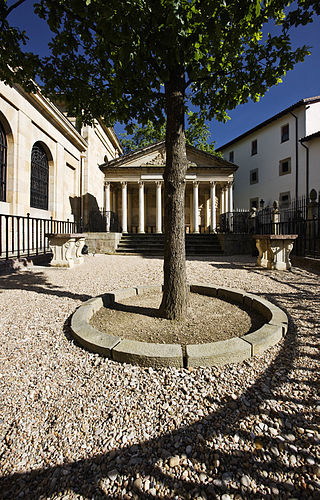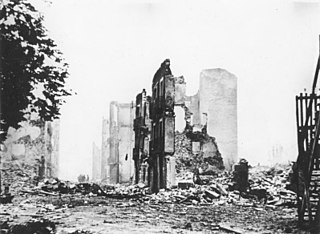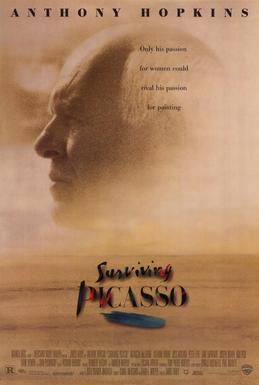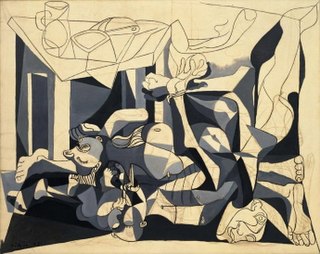Related Research Articles

Guernica, officially Gernika in Basque, is a town in the province of Biscay, in the Autonomous Community of the Basque Country, Spain. The town of Guernica is one part of the municipality of Gernika-Lumo, whose population is 16,224 as of 2009.

Pablo Ruiz Picasso was a Spanish painter, sculptor, printmaker, ceramicist, and theatre designer who spent most of his adult life in France. One of the most influential artists of the 20th century, he is known for co-founding the Cubist movement, the invention of constructed sculpture, the co-invention of collage, and for the wide variety of styles that he helped develop and explore. Among his most famous works are the proto-Cubist Les Demoiselles d'Avignon (1907) and the anti-war painting Guernica (1937), a dramatic portrayal of the bombing of Guernica by German and Italian air forces during the Spanish Civil War.

The Museo Nacional Centro de Arte Reina Sofía is Spain's national museum of 20th-century art. The museum was officially inaugurated on September 10, 1992, and is named for Queen Sofía. It is located in Madrid, near the Atocha train and metro stations, at the southern end of the so-called Golden Triangle of Art.

On 26 April 1937, the Basque town of Guernica was aerial bombed during the Spanish Civil War. It was carried out at the behest of Francisco Franco's rebel Nationalist faction by its allies, the Nazi German Luftwaffe's Condor Legion and the Fascist Italian Aviazione Legionaria, under the code name Operation Rügen. The town was being used as a communications centre by Republican forces just behind the front line, and the raid was intended to destroy bridges and roads. The operation opened the way to Franco's capture of Bilbao and his victory in northern Spain.

Guernica is a large 1937 oil painting by Spanish artist Pablo Picasso. It is one of his best-known works, regarded by many art critics as the most moving and powerful anti-war painting in history. It is exhibited in the Museo Reina Sofía in Madrid.

George Lowther Steer was a South African-born British journalist, author and war correspondent who reported on wars preceding World War II, especially the Second Italo-Abyssinian War and the Spanish Civil War. During those wars he was employed by The Times, and his eye-witness reports did much to alert western nations of war crimes committed by the Italians in Ethiopia and by the Germans in Spain, although little was done to prevent them by the League of Nations, and his 1937 exclusive on the bombing of Guernica inspired Pablo Picasso to paint his anti-war masterpiece, Guernica. He returned to Ethiopia after the world war started and helped the campaign defeat the Italians and restore Hailie Selassie to the throne.

Marie-Thérèse Walter was a French model and lover of Pablo Picasso from 1927 to about 1935 and the mother of their daughter Maya Widmaier-Picasso. Their relationship began when she was seventeen years old; he was 45 and married to his first wife, Olga Khokhlova. It ended after Picasso moved on to his next relationship, with artist Dora Maar. Walter is known as Picasso's "golden muse" and inspired numerous artworks and sculptures that he created of her during their relationship.
Guernica is a Spanish Basque town and historical capital of Biscay.

Surviving Picasso is a 1996 American biographical drama film directed by James Ivory and starring Anthony Hopkins as the famous painter Pablo Picasso. It was produced by Ismail Merchant and David L. Wolper. Ruth Prawer Jhabvala's screenplay was loosely based on the 1988 biography Picasso: Creator and Destroyer by Arianna Stassinopoulos Huffington. It was a box-office bomb, grossing $2 million at the box office against a budget of $16 million.

The Weeping Woman is a series of oil on canvas paintings by Pablo Picasso, the last of which was created in late 1937. The paintings depict Dora Maar, Picasso's mistress and muse. The Weeping Woman paintings were produced by Picasso in response to the bombing of Guernica in the Spanish Civil War and are closely associated with the iconography in his painting Guernica. Picasso was intrigued with the subject of the weeping woman, and revisited the theme numerous times that year. The last version, created on 26 October 1937, was the most elaborate of the series, and has been housed in the collection of the Tate Modern in London since 1987. Another Weeping Woman painting created on 18 October 1937 is housed at the National Gallery of Victoria and was involved in a high-profile political art theft.

Massacre in Korea is an expressionistic painting completed on 18 January 1951 by Pablo Picasso. Picasso's third anti-war painting after Guernica and The Charnel House, Massacre depicts a scene of a massacre of a group of naked women and children by a firing squad. It has been considered to be a condemnation of American intervention in the Korean War. The painting was exhibited in the Musée Picasso in Paris.

The Dream and Lie of Franco is a series of two sheets of prints, comprising 18 individual images, and an accompanying prose poem, by Pablo Picasso produced in 1937. The sheets each contain nine images arranged in a 3x3 grid. The first 14, in etching and aquatint, are dated 8 January 1937. The remaining four images were added to the second printing plate later, without use of aquatint, and dated June 7, 1937.
Minotauromachy is a 19.5 by 27.4” etching and engraving created by Spanish artist Pablo Picasso in Paris in 1935. The etching and resulting prints, literally entitled Minotaur Battle, feature many compositional aspects and themes seen often in Picasso’s art throughout the 1930s. These include the Minotaur, an unconscious or dying female matador on an injured horse, a young girl holding a candle and flowers, a man scaling a ladder, and two women watching with doves from a window. Created during a time of personal turmoil within which Picasso created little artwork, Minotauromachy stands out as a seminal and striking piece with no shortage of artistic interpretations.

The Château of Vauvenargues is a fortified bastide in the village of Vauvenargues, situated to the north of Montagne Sainte-Victoire, just outside the town of Aix-en-Provence in the south of France.

The Charnel House is an unfinished 1944–1945 oil and charcoal on canvas painting by Spanish artist Pablo Picasso, which is purported to deal with the Nazi genocide of the Holocaust. The black and white 'grisaille' composition centres on a massed pile of corpses and was based primarily upon film and photographs of a slaughtered family during the Spanish Civil War. It is considered to be the second of three major anti-war Picassos, preceded by Guernica in 1937 and succeeded by Massacre in Korea in 1951. The painting is housed in the Museum of Modern Art in New York City.
Juan Larrea Celayeta was a Spanish essayist and poet.

Guernica is a 2016 Spanish-British-American war romance drama film directed by Koldo Serra, starring James D'Arcy, María Valverde and Jack Davenport. It is the first feature film made about the 1937 bombing of Guernica.

Dove is a 1949 lithograph on paper created by Pablo Picasso in 1949 in an edition of 50+5. The lithograph displays a white dove on a black background, which is widely considered to be a symbol of peace. The image was used to illustrate a poster at the 1949 Paris Peace Congress and also became an iconographic image of the period, known as "The dove of peace". An example is housed in the collection of the Tate Gallery and MOMA. Since then, it has been considered a masterpiece.

Femme au béret et à la robe quadrillée is an oil-on-canvas painting by Pablo Picasso, which he created in 1937. It is a portrait of Marie-Thérèse Walter, Picasso's lover and muse during this period and was created with elements of Cubism. The painting signifies a transition in their relationship by combining Walter's profile with that of Picasso's new lover, the Surrealist photographer Dora Maar, with whom he began a relationship in 1936. This portrait was produced in the same year as Guernica and The Weeping Woman, a significant phase in Picasso's artistic career. On 28 February 2018, it was sold at Sotheby's auction for £49.8 million, making it one of the most expensive paintings ever sold at an auction in Europe.
References
- ↑ "Guernica". unifrance.org. Retrieved 2014-04-03.